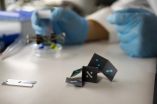(Press-News.org) Washington, DC – A collaborative team of researchers at Children's National Medical Center are making progress in understanding how to protect infants needing cardiac surgery from white matter injury, which impacts the nervous system. The synergistic team from the Children's National Heart Institute and Center for Neuroscience Research at Children's National Medical Center was led by Nobuyuki Ishibashi, MD, Joseph Scafidi, DO, Richard Jonas, MD, and Vittorio Gallo, PhD. The study, published online in the January edition of Circulation, identifies the stages of white matter development, as well as the areas and cells of the brain that are impacted by the amount of oxygen and any inflammation in infants with complex cardiac issues that affect brain oxygenation and cause swelling.
The most common neurological deficits seen in children with CHD requiring cardiac surgery are fine and gross motor deficits, which are consistent with white matter injury. The study, using a porcine cardiopulmonary bypass (CPB) model, monitored how the regions of white matter responded to CPB at 1, 3, and 7 weeks of age. In some groups, observation involved CPB with lack of oxygen (hypoxia) and inflammation. The results found that white matter injury was dependent on the area's stage of maturity. Additionally where there was hypoxia and inflammation, the team saw a halt in the progression of white matter development, or oligodendroctye cell maturation and lineage, which is known to lead to neurological deficits. Four weeks after surgery with CPB that induced hypoxia and inflammation, the team determined that white matter cells were no longer growing and maturing, a finding consistent with the neurological deficits in complex congenital heart disease patients, who are at higher risk of ischemia and inflammation that often occur after frequent hypoxia.
"Being able to identify the stage in which certain cells are more vulnerable to disruptions brings us much closer to understanding the mechanisms of white matter injury and could eventually help us create strategies and treatment methods to protect those cells in young patients who will need to undergo cardiopulmonary bypass," stated Nobuyuki Ishibashi, MD, lead author of the study and Laboratory Director of Cardiac Surgery. "This study also provides evidence that CPB surgery must be managed precisely to avoid inducing further hypoxia and inflammation in these already fragile patients."
Oligodendrocyte cells are the type of brain cells that make up white matter and serve as the primary messaging "network" that conducts signals rapidly between gray matter areas. Without it, the brain does not function properly. Myelination, or growth of white matter, in humans begins in utero at around 5 months of gestation and continues throughout the first two decades of life. This process involves the maturation of oligodendrocyte cells through different stages; if there is a disruption, for example from a lack of oxygen or inflammation, these cells and the subsequent stages, or lineage, can't develop the way that they should, resulting in neurological deficits.
"Interestingly, the white matter response we saw in the group that experienced hypoxia and inflammation is very similar to what you see in patients with complex congenital heart disease," stated Richard Jonas, MD, Chief of Cardiac Surgery. "If we can start to understand the mechanics of white matter development and how a lack of oxygen and inflammation affects the brain, we will be able to contribute to the treatment strategies for patients with congenital heart disease." Congenital heart disease is the leading birth defect, affecting almost one in every 100 infants each year. For successful white matter development in congenital heart disease patients, it is imperative to understand how CHD and its treatments affect the growth and repair of white matter.
Director of the Center for Neuroscience Research, Vittorio Gallo, PhD, commented "This study provides us with further evidence of the critical time windows that exist in white matter development and the importance of understanding the mechanisms of white matter development so that we might possibly ease white matter damage in patients."
Myelination, white matter growth and repair, and the study of complex mechanisms of prenatal brain development are a key focus of the Center for Neuroscience Research at Children's National, which also houses the White Matter Diseases Program, one of the largest clinical programs in the country for treating children with disorders that cause the brain's white matter to degenerate. Congenital heart disease and other cardiac conditions are the main priority of the Children's National Heart Institute, an international leader in providing comprehensive care for infants, children, and adults.
INFORMATION:
Related Links
Read the study abstract in Circulation
Learn more about Children's National Center for Neuroscience Research
Read more about white matter research at Children's National Medical Center
Find out about the clinical care that Children's provides through the White Matter Disease Program
Find out more about Children's National Cardiology Division and the Children's National Heart Institute
Contact Emily Hartman or Emily Dammeyer at 202-476-4500.
About Children's National Medical Center
Children's National Medical Center in Washington, DC, has been serving the nation's children since 1870. Home to Children's Research Institute and the Sheikh Zayed Institute for Pediatric Surgical Innovation, Children's National is consistently ranked among the top pediatric hospitals by U.S.News & World Report and the Leapfrog Group. Children's National is a Magnet® designated hospital. With 303 beds and eight regional outpatient centers, Children's National is the only exclusive provider of acute pediatric services in the Washington metropolitan area. For more information, visit ChildrensNational.org, or follow us on Facebook and Twitter.
END
Philadelphia, PA, March 6, 2012 – The Canadian Journal of Cardiology has published a paper on the effect of socioeconomic factors on myocardial infarction outcomes.
This study describes an analysis of the effect of socioeconomic class on outcomes after a first myocardial infarction ("heart attack"). The study analyzed detailed databases in Quebec and found that socioeconomic deprivation did not negatively affect access to the most advanced high-level health care – clearly a success for the Canadian public healthcare system. Nevertheless, mortality rates were slightly ...
AUSTIN, Texas — Inspired by the paper-folding art of origami, chemists at The University of Texas at Austin have developed a 3-D paper sensor that may be able to test for diseases such as malaria and HIV for less than 10 cents a pop.
Such low-cost, "point-of-care" sensors could be incredibly useful in the developing world, where the resources often don't exist to pay for lab-based tests, and where, even if the money is available, the infrastructure often doesn't exist to transport biological samples to the lab.
"This is about medicine for everybody," says Richard Crooks, ...
Young America, http://www.young-america.com, an incentive marketing firm, has hired Steve Schulte as senior sales executive responsible for new business development initiatives and strategic growth focusing on opportunities among large clients.
Prior to joining Young America, Schulte worked for Restaurant.com as national account manager. He previously held leadership positions in the sales departments of loyalty and incentive companies Maritz, Inc. and Meridian Enterprises, and has experience in the technology, automotive, hospitality and insurance industries. He holds ...
Sometimes the fastest pathway from point A to point B is not a straight line: for example, if you're underwater and contending with strong and shifting currents. But figuring out the best route in such settings is a monumentally complex problem — especially if you're trying to do it not just for one underwater vehicle, but for a swarm of them moving all at once toward separate destinations.
But that's just what a team of engineers at MIT has figured out how to do, in research results to be presented in May at the annual IEEE International Conference on Robotics and Automation. ...
Feeling angry and annoyed with others is a daily part of life, but most people don't act on these impulses. What keeps us from punching line-cutters or murdering conniving co-workers? Self-control. A new review article in Current Directions in Psychological Science, a journal of the Association for Psychological Science, examines the psychological research and finds that it's possible to deplete self-control—or to strengthen it by practice.
Criminologists and sociologists have long believed that people commit violent crimes when an opportunity arises and they're low on ...
COLUMBIA, Mo. –Veterans are almost twice as likely as the general public to have chronic illnesses, such as diabetes and heart failure. Therefore, veterans may require more assistance from informal caregivers, especially as outpatient treatment becomes more common. A University of Missouri researcher evaluated strain and satisfaction among informal caregivers of veterans with chronic illnesses. The findings show that more than one third of veterans' caregivers report high levels of strain as a result of taking care of their relatives; yet, on average, caregivers also report ...
COLUMBIA, Mo. – Though women are better represented in the workforce and in higher education institutions, they still face barriers in employment, education and health care access and are more likely to live in poverty. Now, a University of Missouri expert says new research highlighting current issues affecting Missouri women provides insights that could significantly improve the lives of women throughout the state.
Kristin Metcalf-Wilson, an assistant teaching professor in the MU Sinclair School of Nursing, helped compile the Missouri Women's Report. The report includes ...
The 2011 Tohoku tsunami was Japan's deadliest in more than 100 years. Despite an extraordinary level of preparedness by the Japanese, the tsunami caused more than 90 percent of the almost 20,000 fatalities last March.
Georgia Tech Associate Professor Hermann Fritz and his research team are studying the impact of the tsunami on the Sanriku coast.
Using eyewitness video and terrestrial laser scanners from atop the highest buildings that survived the tsunami, Fritz has mapped the tsunami's height and flood zone to learn more about the flow of the devastating currents.
Fritz's ...
In both war and peacetime scenarios, fire in the shipboard environment is serious and frequently results in excessive damage and high repair costs because the fire is not detected or controlled adequately. To help further improve future shipboard firefighting capability scientists at the Naval Research Laboratory have formed an interdisciplinary team to develop a humanoid robot that could fight fires on the next generation of combatants. A humanoid-type robot was chosen because it was deemed best suited to operate within the confines of an environment that was deigned ...
Perspective Magazine announces that Holiday Systems International (HSI) has renewed its sponsorship package for the Third Annual Global Networking Expo, GNEX 2013 - The Global Meeting Of Minds. The agreement will provide HSI with exclusive sponsorship of the Perspective Magazine Awards Program and Platinum-level sponsorship for the event, to be held at the world famous Beverly Wilshire - A Four Seasons Hotel on February 4-6, 2013.
"GNEX is in touch with the industry and continues to demonstrate their Expo is valuable to the attendees," said Craig Morganson, ...

